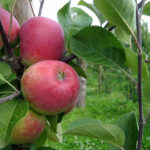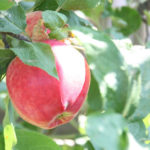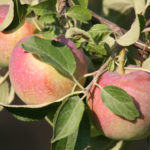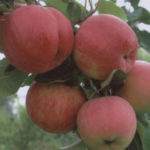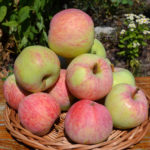Pear variety Carmen
Usually, the fruits of pear trees are not as brightly colored as, for example, apple trees. But there is a good exception to the rule - this is Carmen's pear. Sources claim that this is the first Russian variety for central Russia to have fully colored fruits. It was created at the All-Russian Research Institute of Genetics and Breeding of Fruit Plants named after V.I. I.V. Michurin. A group of scientists worked on the creation of the novelty: S.P. Yakovlev, A.P. Gribanovsky, Yu.K. Ilyin. Daughter Blankova and Williams red were used as initial forms for hybridization. Our heroine is not included in the State Register. But in 1992 it was accepted into the program of state variety trials. Currently, the variety is not widespread and is grown mainly in the Central Black Earth Region.
By the way, our heroine has a namesake, but she belongs to the Italian selection. It appeared in 1989, and in 2006 received a European patent. The name Carmen continued the tradition of Italian breeders to give their children the names of opera heroines. The Italian pear also belongs to the summer varieties and ripens at about the same time as the Russian Carmen. But our compatriot looks much brighter than the Italian, whose color is more modest.

Description
The plant is described as fast growing. Distinctive features of the tree are moderate height (about 5.0 meters) and a dense, compact crown of a narrow pyramidal shape, which allows planting varietal trees quite densely - up to 10 - 12 pieces per hundred square meters. Due to the narrow-pyramidal outlines of the crown, many classify the variety as a columnar crop. The main branches are strong, not very long, departing from the trunk at an acute angle. The growing shoots are rather thick, they grow straight, the bark is brownish-brown, the geniculate is poorly expressed. Lentils are light, small, few in number. The buds of the pear are small, conical in shape, growing, pressing against the shoot. Rounded elliptical or ovoid leaves are green, with a reddish tinge, are of medium size, the apex is short-pointed, the edge is small-crested, even. The leaf blade is weakly folded, curved, the surface is shiny. The leaves are attached to the shoot at an acute angle. The petiole is of regular length and thickness. Stipules are long, subulate.
The shape of the fruit is correct, short pear-shaped, the size is medium, the standard weight is 120 - 170 grams, some specimens can reach 300 grams. The saucer is not wide, shallow, folded. The skin is slightly rough, dry, slightly shiny. Weak wax coating. The color is very noticeable and distinguishes our heroine from other varieties. At the moment of ripening, the entire surface of the pear is covered with a burgundy hue, which by the time of consumer maturity becomes brownish red. The subcutaneous points are numerous, small, light, noticeable. The peduncle is short and thick. The pulp has a light creamy shade, rather juicy, moderately dense, semi-oily, pleasant, light aroma. The taste is sour-sweet, astringency is not felt. 100 grams of pulp contains: sugars 8%, titratable acids 0.12%, P-active substances 135 mg, ascorbic acid 7 mg.
Characteristics
- Carmen's early maturity is average, as a rule, the pear begins to bear fruit 5 years after planting with an annual seedling. Grafting on quince will help speed up the entry into the fruiting period. This harmonious duo will also increase productivity and fruit size, making the tree even more compact;
- in terms of ripening, our heroine belongs to summer crops. Harvest is ready for harvest at the end of July - mid-August. The consumption period lasts only a couple of weeks;
- the yield is average. The downside is that productivity grows very slowly. But there is also a plus - this is the life span of a plant, which lasts from 25 to 50 years. There is information that the yield of one tree is 30 kg;
- according to the observations of gardeners, the culture bears fruit stably and annually.Frequency, even small, was not noticed;
- frost resistance has not been sufficiently described. VNIISPK characterizes this indicator as average, without specific figures. From other sources, it follows that the culture is able to withstand temperatures as low as -30 ° C. Our heroine is often found in the list of varieties suitable for cultivation in central Russia, including in the Moscow region;
- immunity is described as average. But at the same time, high resistance to scab and septoria is declared. In winter, rodents like mice and hares like to feast on pear bark. In wounded trees, winter hardiness decreases, and they become easily vulnerable to diseases and insect pests;
- transportable possibilities are good. Keeping quality is insufficient, however, this is typical of any summer varieties;
- the way of using is universal. Fruit should primarily be consumed in its natural form. But if desired, the crop can be recycled by making jam, preserves, compote, marmalade.
Pollinators
Carmen is a partially self-fertile, bisexual variety. This, of course, gives hope for a harvest in the event that our heroine grows in the garden alone. But to be completely confident that the tree will demonstrate its true capabilities, a reliable pollinator is needed. Will become a good neighbor Williams summer or other early varieties. With a lack of planting space or not wanting to have another summer variety, a pollinator branch can be grafted into the crown to our heroine.
Agrotechnics
Planting pears can be done in early May or late October. Choose a site that is well lit, flat, and a slight slope is allowed. The plant is not particularly picky about soils, loam, black soil, sod-podzolic soil are suitable. The groundwater level to the surface should not be higher than 2.0 - 2.5 meters, since our heroine cannot stand moisture stagnation in the roots. Watering is carried out as needed, taking into account natural precipitation. It is advisable to keep the trunk circle clean and not to plant other plants in it. Since the branches grow at an acute angle, the connection of the wood is not very strong. To remedy the situation, in the first years, when the crown is being formed, with the help of a stretch, give the branches a more horizontal position. The rest of the agricultural technology corresponds to the standard.
Carmen has a number of virtues. The compact size of the crown saves space in the garden. Resistance to the main diseases of the culture - scab and septoria - facilitates care. True, in epiphytic years, without preventive treatments, the plant will not be able to maintain a high level of disease resistance. Gardeners especially appreciate bright, fully colored pear fruits with good taste. But do not be silent about the disadvantages of the variety. After knowing the weaknesses of the plant, you can easily avoid the troubles associated with them. So, due to insufficient frost resistance, trees, especially at a young age, should be insulated in the winter. Also during this period, the trunks should be protected from rodents. But the biggest drawback is still considered to be a slowly increasing yield.
